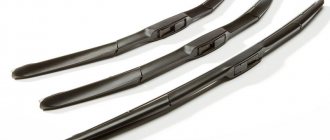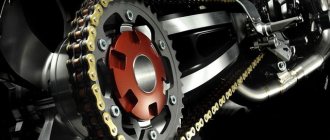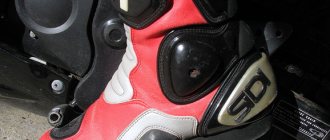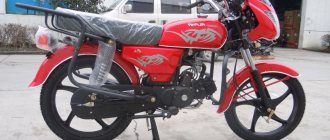Preparation
The first step is purchasing the oil that you are going to pour into the motorcycle engine. Remember that it must exactly match the parameters specified by the vehicle manufacturer. This applies to viscosity, as well as to the presence of special additives in the technical fluid. For two-stroke engines, a special oil is produced that is added to gasoline, so here we will look at replacing the lubricant in a four-stroke engine. “Two-stroke” oil cannot be poured into it, since it is not designed for long-term use and can cause damage to the power unit.
Before changing the oil, the engine must be flushed, since remnants of old fluid and chips accumulated as a result of wear of internal components can quickly damage the unit. The best option is to purchase flushing fluid, which is added to the old oil. It effectively removes all foreign objects from the hydraulic system and does not reduce the life of the power unit. In addition, there is a flushing agent that is added after the old oil has been removed from the engine. In any case, you should follow the recommendations of the fluid manufacturer - when flushing the engine, you need to start the motorcycle and let it run for 10-15 minutes, depending on what is indicated on the canister.
Draining the technical fluid is carried out only when the engine is warm - it must run for at least 2-3 minutes at idle so that the oil temperature reaches 100 degrees and its viscosity decreases significantly. Since you will have to deal with such a high temperature, prepare thick gloves in advance that will protect your hands from painful and difficult-to-heal burns. First you need to find the drain bolt, which is usually located at the bottom of the power unit, and in motorcycles with a dry sump - on the frame. There may be a plastic protection on it - it must be carefully bent to gain access to the neck.
Taking the key to 17, carefully begin to turn the bolt counterclockwise - if you sharply pull it in the opposite direction, you will not be able to avoid crankcase failure. When the bolt turns easily, quickly turn it out with your hands and remove your palms before hot oil pours on them. The lubricant will flow for approximately 15 minutes due to its high viscosity. To ensure complete removal of used oil, you can rock the motorcycle sideways to speed up the process. The oil should be collected in a previously prepared container so as not to cause damage to the environment or create a fire hazard.
If a bolt falls into a can of oil, try to get it out as quickly as possible using a wire hook or a powerful magnet. If dropped in such a way, its sealing copper washer may be damaged, which will lead to depressurization of the lubrication system. In such cases, you need to purchase a new bolt, since repairing it will not provide guaranteed reliability.
Replacement
When there is no old technical fluid in the lubrication system, you will need to change the oil filter to get rid of the chips or dirt accumulated in it. On some motorcycles it is located on the surface of the motor, while on others you have to remove the plastic lining and protective components to gain access. It is better to remove the oil filter using a special puller or a wrench with a chain, so as not to damage the threads. An emergency option is to pierce the body of the cleaning element with a screwdriver and use it as a lever. However, you need to make sure that the rod does not touch other components of the engine and fuel system.
A little hot oil may spill out of the filter mounting hole, so you should not remove the container for collecting it and gloves yet. A little clean oil is first poured into the new part. It is also necessary to lubricate the rubber O-ring to ensure the tightness of the hydraulic circuit. The filter is twisted until it stops by hand, after which it is pulled out a quarter turn with a wrench. However, you should not show excessive enthusiasm - a broken thread can cause complex, expensive repairs.
After screwing on the filter, reinstall the drain plug and plastic protection. Experts who know how to change the oil on a motorcycle advise to stock up on a funnel in advance that will fit well against the walls of the filler neck. If the diameter differs significantly, some of the lubricant may splash out, which leads to contamination of the vehicle. The filler plug is screwed on as tightly as possible, but you should not be zealous here either. To check the oil level, you need to run the engine for 2-3 minutes and then cool it for 5 minutes.
Lack of oil in a motorcycle engine often causes cylinder scuffing, which requires a major overhaul of the power unit. Therefore, if the level on the dipstick is below the minimum allowable, it is necessary to add the required amount of lubricant, and then repeat the procedure with warming up. Excessive amounts of lubricant also negatively affect the reliability of two-wheeled vehicles - so you should not be lazy to drain the excess if there is any. The most common problems associated with oil overfilling are squeezed out oil seals and seized pistons. Therefore, it is necessary to follow the manufacturer’s instructions, which are indicated in the instructions or on the official website.
What will happen if the oil change intervals are “extended” as much as possible?
One of the most serious problems can be turning of the connecting rod bearings. The more tired the engine oil is, the faster the oil channels become clogged. The connecting rod bearings are subjected to excessive loads, which means heating, which leads to their rotation.
Of course, this is an extreme case, but a “reduced” resource, lower compression and developed power, higher heat load while saving on engine oil changes will be guaranteed companions of your power unit.
In such situations, each subsequent owner bears great risks, almost like in a financial pyramid; the chain of luck will end with one of the next “lucky” investors. That's why buying on the secondary market is always a lottery, and that's why we overpay for new equipment.
In this regard, purchasing high-quality motor oil seems to be a very important task. The Total company has been in the motor oil market for more than 50 years and occupies one of the leading positions in the global market, and its Elf brand has a full line of motorcycle oils, ranging from purely racing products to a mineral line, as well as various motorcycle chemistry. It is worth mentioning separately the wide range of oils specially created for two-stroke engines:
- MOTO 2 OFFROAD
- MOTO 2 SELF MIX
- MOTO 2RACE
- MOTO 2 TECH
The company also has two largest research centers in France and India, participation in the world's most prestigious racing series such as MotoGP and WSBK, which certainly gives impetus to the development of technology, and cooperation with global automakers: Renault, Nissan, Dacia and Datsun .
Of course, all products comply with key ISO, API and JASO certification standards. And the motorist just has to choose an ELF product that matches his class of equipment and, of course, do not forget that nothing lasts forever.
Z900RSTags
Elf Oil change Educational program
Correct oil change
The procedure should be performed in a garage in good lighting and at normal ambient temperatures. If the garage is not heated, it is better to avoid changing the oil in winter - it may thicken and not completely drain from all moving joints, which will subsequently cause them to break. The garage must be clean so that dust and other foreign impurities do not get into the oil - this is why the procedure is not recommended to be performed in the open air. After replacing the technical fluid, the engine should be run in, which will allow it to achieve a high level of reliability. You need to break in the motorcycle at medium speeds - at idle speed, solid deposits can form in the hydraulic system, and at high crankshaft speeds, the engine can wear out very quickly.
Motorcycle oil change
The health and productivity of a vehicle depends on the quality of the oil poured into the engine. With periodic maintenance, the engine works properly and does not create any problems for the motorcycle owner. But if the engine oil is changed rarely and incorrectly, the motorcycle will quickly become unusable, and repairs will be very expensive for the owner. The process of changing the oil contains many nuances, so before you begin this difficult task, find out how to properly change the oil in a motorcycle.
So when does a motorcycle engine oil need to be changed?
The oil change interval for a motorcycle engine, as mentioned above, can vary greatly. If you do NOT have sports equipment that is subjected to extreme loads, where changing the oil after each race is commonplace, then it is better to keep the average maintenance interval in the region of 5000-7000 kilometers. No matter what the factory labels say.
If we talk about sportbikes in general, the company has a whole line of high-quality synthetics for them:
Of course, everything is individual, for example, powerful cruisers with large-capacity engines, operated primarily on the highway in the speed range of up to 120 - 130 km/h, will easily tolerate an oil change every 12,000 - 15,000 kilometers. The following ELF oils are best suited for this class of motorcycles:
Another question is that any oils lose some of their properties after such a mileage. And those same large-capacity “air vents” really don’t like overheating, after which even the highest quality oil will be suitable for only one thing: immediate replacement.
In any case, mediocre fuel (and there is still plenty of this in our open spaces) forms carbon deposits during combustion, gradual oxidation of the oil occurs, burnout of additives... All this leads to increased loads on the piston group, transmission units, and, as a result, to a decrease in service life .
The main thing you need to understand when asking about the frequency of oil changes is the four main aspects for which the oil is actually responsible.
True, new motorcycles often change their owner after a season or two, and, knowing in advance about such prospects, the first owner can save on the frequency of changes, knowing full well that the engine’s life will be enough for his share.
Periodicity
Every motorist has thought at least once about how often the engine oil should be changed. In the operating instructions they say one thing, on websites for motorcycle racers they say something else, and friends from the club say something else. To understand this topic, it is enough to know the following.
The frequency of oil changes depends on your driving style. With frequent gear changes, sudden acceleration and braking, as well as constant speed changes, the oil quickly turns black. This style of riding is typical for cities: stops at traffic lights alternate with rapid increases in speed, which is why the motorcycle engine works at the limit. Large loads on the engine require additional resources from the oil, so it has to be changed many times more often. In urban conditions, a motorcycle can travel 5000-6000 km with semi-synthetic oil, and up to 7000 km with synthetic oil. If the motorcycle is used for enduro riding and long-distance travel, the oil can be changed every 11,000-12,000 km.
Changing the oil on the training motorcycles of the Autofactor motorcycle school is based not on mileage, but on the number of astronomical hours worked on the site (motor hours). In the range of 300 – 350 hours, the oil and oil filter are changed (once a month), plus the technical condition of the motorcycle is diagnosed. Maintenance and repair of educational equipment is included in the cost of training for category “A”.
Another condition to pay attention to is roads. Motorcycles do not like uneven roads: gravel, dirt roads, potholes and potholes. On such roads, the engine oil will deteriorate much faster, so you will have to change it more often.
Some people believe that it is enough to follow the recommendations of the factories, and everything will be fine. But this is a misconception. The fact is that when calculating such parameters, factories use average values. That is, these figures will be reliable for motorcycles used under ideal conditions: at medium tachometer speeds, riding with the throttle partially open and the engine not overheating. Motorcycle manufacturers do not know in what conditions a particular vehicle will be used. Driving in dusty, dirty or wet areas, constantly idling in traffic jams, daily jerks on sportbikes - all these situations require attention and reduction in oil change intervals.
Important! Even the highest quality oil gradually loses its lubricating properties. Oxidation processes constantly occur in the oil; in 1 year its effectiveness decreases by almost 40%. Therefore, even if you haven’t reached the level required for an oil change in a year, check the quality of the oil and replace it if necessary.
When do you really need to change your motorcycle engine oil?
Visually assessing the condition of the filled oil and the degree of its consumption is still the best and safest means of control. After all, sometimes the on-board computer optimistically informs you about the next oil change only after 5,000 kilometers, and before your eyes you see a black substance at the “Min” mark of the oil dipstick.
In theory, everything is simple - there are factory recommendations, and you need to adhere to them... But often this is not entirely true, because these calculations are valid for some, let's call them, let's say, ideal conditions of load on the internal combustion engine - average tachometer speed, partially open throttle, lack of engine overheating.
But such greenhouse conditions do not always coincide with real ones: it is necessary not only to mindlessly follow the factory instructions, but to proceed from objective factors and, if necessary, reduce the oil change time.
Driving through mountainous or very dusty areas, enduro rides or daily city runs on sportbikes with the tachometer turned to the red zone and balancing on the rear wheel, thoughtful crawling in traffic jams with the cooling system fan constantly on - this is not a complete list of situations that do not coincide with data perfectly verified by marketers from the “official” health book of your motorcycle.
By the way, the story of low mileage and gentle operation also has its own nuances. After all, oil is a chemical compound that can oxidize and degrade over time, so even if you haven’t completed the required kilometers, then after a year it needs to be replaced.
Yes, in modern expensive oils, such as semi-synthetic and synthetic Elf oils, the proportion of polyalphaolefins (PAO) or esters in the composition can reach up to 15-20%, they have excellent viscosity and lubricating properties, but their resource is also finite . So to believe that after 10,000 kilometers their properties have not changed in any way is at least naive.
Esters are esters that are obtained by esterification with alcohols of carboxylic acids obtained through the hydrolysis of vegetable oils (rapeseed oil or coconut copra oil).
The main advantage of oils with esters is the strength of the oil film formed by an ester-based lubricant, which is 22,000 kg per square centimeter. This is much higher than that of PAO oils (conventional synthetic oils).
How to look after your oil
Despite current recommendations on how often you should change your oil, the best way to ensure your engine's health is through periodic checks. The engine oil is changed in two cases: if it runs out or if it has deteriorated. To check the oil level, place the motorcycle on a level surface. If the motorcycle has only one side stand, try to fix it on the weight in a more or less level state. When checking the oil, the engine must be cool and the oil not viscous. If the motorcycle has recently been started, wait 30-50 minutes until it cools down and the oil drains down.
Level check
Excess oil in the crankcase causes hydraulic shock, squeezed out oil seals and seized pistons. A lack of oil can result in a seized engine and a failed engine. You can find out the fluid level either using a dipstick or through an inspection window. If the crankcase is more than half empty, add oil. Otherwise, oil starvation will begin.
The dipstick is attached to the inside of the oil filler cap. To check the oil level, unscrew the dipstick counterclockwise and wipe dry with a rag or paper towel. After this, lower the dipstick into the oil filler neck until it stops, without twisting it. Carefully pull it out, holding it horizontally and not allowing oil to spill on the dipstick. The oil level should be between the “High” and “Low” values. If necessary, add oil or drain it.
The main condition for correctly assessing the oil level through the crankcase inspection window is that the motorcycle is level. If the body is tilted to the right or left even a few millimeters, you will not be able to obtain reliable information. After the motorcycle has cooled down, visually check the oil level in the crankcase. It should not be higher than o or lower than o.
Quality checking
The quality of the oil is determined by its color. If the fluid is yellow or light brown, the oil is fine. This color is considered normal and replacement is not required. Black or dark brown color indicates burnt or used oil; in this case, replacement is required as soon as possible.
Metal particles that may be present in the oil indicate engine wear, and a milky white color of the fluid indicates damage to the cooling system. In both cases, you should immediately contact a workshop to find the cause and solve the problem.
Consequences of untimely replacement
If you constantly delay caring for your motorcycle, increasing the intervals between oil changes, the results will not be long in coming. Damaged oil ceases to perform its functions, and the mechanism begins to be damaged. The oil thickens, becomes too viscous and, instead of making engine operation easier, makes it more difficult. The engine begins to overheat, parts rub against each other, as the lubricant does not work efficiently, and the condition of the vehicle deteriorates. Here is a list of malfunctions that are caused by untimely oil changes:
When to change the oil
There is no exact answer to this question. Most motorists prefer to change the oil regardless of the time of year. Professionals advise changing the oil twice a year: before wintering, to “preserve” the motorcycle, and at the beginning of each season, that is, in the spring. Usually the motorcycle is not used in winter. If the oil was burnt or used before wintering, it can seriously damage the engine after 3 months of standing in the cold. While the motorcycle is not in use, the oil “does not work”, but is actively oxidizing, and by spring its quality may deteriorate significantly. To avoid problems associated with spoiled oil, it is recommended to change the oil twice a year.
How often to change engine oil
Both excess oil and its lack are dangerous. If the oil level is too high, water hammer may occur. If its level is too low, the engine will fail.
Each manufacturer gives its own recommendations for changing engine oil. The general rule is to change the oil every six thousand kilometers. This is usually done once a year before wintering. So the answer to the question “when to change the engine oil?” you already know. In this case, during the winter, sediment does not form from the remaining debris on the inner surface of the engine.
Oil change tools
It is impossible to change the oil in a motorcycle engine with bare hands. To avoid damaging any parts of the mechanism, use the recommended tools. Before starting the procedure, prepare all the necessary tools and place them next to you, since you cannot leave the motorcycle unattended. In addition, hands stained with motor oil will make it difficult to find missing tools.
Important! Wipe down tools before and after use. When changing the oil, all tools must be clean, free of dirt and dust. The fact is that even a small grain of sand that accidentally gets into the engine can damage the motorcycle.
List of required tools:
How to change oil: work progress
Before you start changing your oil, make sure you find a suitable location. Most often this is done in the garage. To ensure a safe oil change process, follow several conditions. Firstly, you need to change the oil in the light in order to be able to notice in time whether parts are faulty or the quality of the oil is poor. Secondly, the garage should not be too cold. Changing the oil at subzero temperatures is not recommended. And thirdly, before starting the procedure it is necessary to carry out cleaning. Dust and dirt that gets into a motorcycle engine will quickly damage it. To avoid this, take care of the cleanliness of the room.
Preparation
The most important stage of preparation is the choice of oil. This point cannot be neglected, since an incorrectly selected fluid can damage the entire mechanism.
Before changing the oil, warm up the motorcycle engine to operating temperature. Changing the oil on a cold engine is much more difficult. To warm up the motorcycle, start it and let it idle for 15-20 minutes. If you are going to flush the engine, there is no need to warm up the motorcycle at this stage. After warming up, place the motorcycle on the center stand on a flat surface. If the motorcycle is installed crookedly, the process will take longer as the oil will take longer to drain. In addition, you will not be able to accurately determine the level of the filled oil, which can lead to dire consequences.
Flushing
Sometimes, before changing the oil, it is necessary to flush the engine with a special fluid. It is necessary to flush the crankcase only in the following cases.
There are 2 types of flushes: one is poured into the engine only after draining the used oil, while the other is added directly to the oil, which significantly saves time.
Method 1.
The flushing liquid is poured into an empty tank after the used oil has already been drained. After this, the engine starts and idles for 15-20 minutes. The exact time will be indicated on the packaging. Then the wash is drained, the oil filter is replaced with a new one and the tank is filled with new oil. The disadvantage of this method is that it is impossible to drain the flush completely, so it partially remains in the engine, where it reduces viscosity and impairs the cleaning properties of the oil.
Method 2.
This fast-acting flushing liquid is sometimes called “five-minute.” The flush is filled with used oil, which is planned to be replaced. Then the engine, just as in the previous paragraph, starts and runs for a while, after which the flushing is drained along with the oil. This washing liquid is made on the basis of kerosene, due to which it completely evaporates within 20-30 minutes. Thus, it does not harm the fresh oil in any way and does not impair engine performance. In addition, the oil filter does not need to be changed when using quick flushing.
Draining old oil
You will need thick gloves for this step. First, find the drain bolt: it is located either under the power unit or on the frame. If there is a plastic protector, carefully peel it back to gain access to the neck. After this, take a wrench of the appropriate size and turn the bolt counterclockwise. Place the oil drain pan directly below the bolt. Look carefully at where the oil will flow and place the container in that place. You may have to move the pan several times as the oil will begin to flow out more slowly over time.
Completely draining the oil will take 15-60 minutes - the time depends on the engine temperature and the type of engine oil. Make sure that all the oil has drained out by rocking the motorcycle from side to side. Do not pour used oil into a drain or ditch as this is harmful to the environment. To dispose of oil, pour it into a plastic bleach or detergent container and screw the lid on tightly. After this, take the oil to the nearest landfill and leave it there.
Important! If the drain bolt has fallen into the oil pan, try to pull it out as quickly as possible using a wire hook or magnet. After this, check whether the sealing copper washer has fallen off the bolt. If it's missing, you'll need a new bolt.
Change of oil
The oil filter is replaced at this stage. Using a suitable wrench, unscrew the old oil filter. If you don't have a key, use a screwdriver or a long nail. Fill the filter 1/4 full with oil. Shake it gently to coat all parts with oil. After this, lubricate the O-ring with oil: this will ensure better contact with the engine. Screw the filled filter back in.
After you have filled the filter with oil, pour engine oil into the neck. To prevent it from spilling onto other parts, use a funnel. The oil level should not reach the upper mark; it is better to leave it slightly below the maximum level. Having done all this, tighten the filler cap.
Motorcycle break-in
Run the engine for 5-7 minutes, then check the oil level. If everything is in order, then you have completed this difficult task and managed to change the oil!
Source
How to change engine oil
And the oil filter can be changed every other time, that is, every twelve thousand kilometers. Before changing the oil, you can add a thinner to the old oil and run the engine at idle speed for 15 minutes. This will help clean the inside of the engine and any dirt will be collected in the filter. And the filter will have to be changed.
The oil change procedure is simple, you can do it yourself. The rear wheel should be on a stand. The filler plug and drain plug are unscrewed. The oil must drain; to do this, you need to place a container. Now you need to unscrew the oil filter. Let's get rid of the oil here too. Once the oil is completely freed, the drain screw can be tightened only with a little force.
A new oil filter is installed. Oil is poured in the amount specified in the manual specifically for your motorcycle. You also change the oil in the steering damper.
Remember that with constant use of a motorcycle, both water and products of oxidation and oil decomposition accumulate in the engine. All this weakens the properties of the oil and impairs engine performance. Therefore, follow the recommended oil change measures prescribed by the manufacturer.









